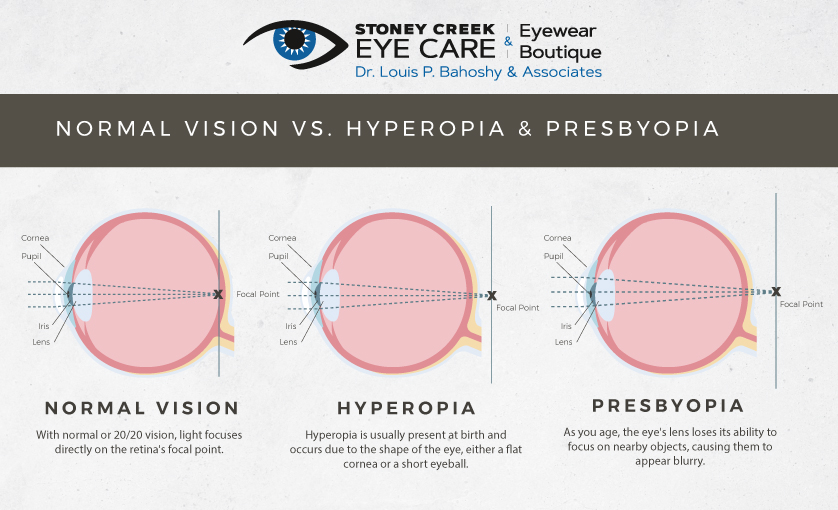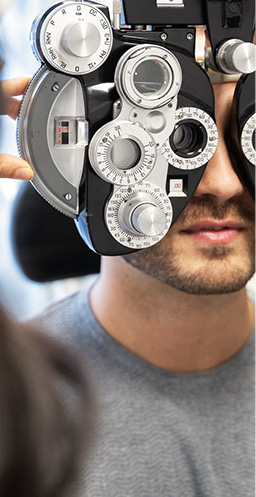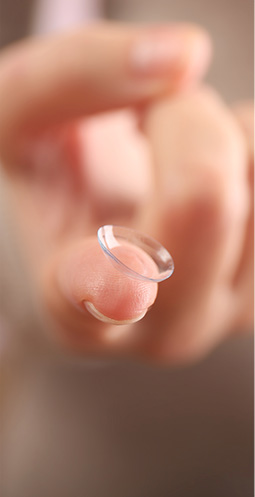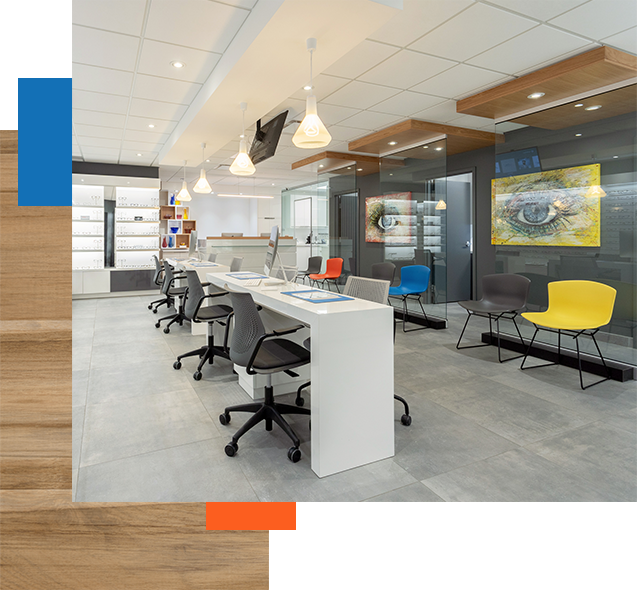What is Presbyopia?
Presbyopia is a refractive error that makes it difficult to see close objects. The effects are similar to hyperopia (farsightedness), but the root cause is different. Hyperopia occurs due to the shape or length of the eyeball and most people are born with this refractive error. Presbyopia, on the other hand, is caused by stiffening of the eye’s lens.

As you age, the lens loses its elasticity. Over time, it becomes more difficult for the lens muscles to contract, preventing your eye from changing focus. This causes close objects to appear blurry because the eye can no longer focus properly at objects within arm’s length.
Who Gets Presbyopia?
Presbyopia typically happens around age 40 as part of the ageing process. The changes in your eye’s lens elasticity usually occur over 10 years, meaning you will likely need to update your corrective lenses every 2 to 3 years between the ages of 40 to 60. Beyond that, changes in the distance prescription will also impact the near prescription as the two are linked.
Prescription changes are one of the reasons why regular eye exams are so important, especially as you age. Make sure you’re visiting your optometrist at least every 2 years, and once per year if you’re over 60. An eye exam is the only way to diagnose presbyopia and ensure that your glasses or contacts are providing you with the best vision possible.
Risk Factors
The main risk factor for presbyopia is ageing. It’s a natural part of the ageing process and cannot be prevented. However, there are certain factors that can increase your risk of presbyopia, particularly premature presbyopia (presbyopia that occurs before age 40).
These risk factors include certain medical conditions:
- Diabetes
- Multiple sclerosis
- Heart disease
Certain medications like antidepressants, antihistamines, and diuretics can also increase your risk of developing presbyopia.
Symptoms
The most telling indicator of presbyopia is the inability to see things close objects well. You’ll likely notice that you can’t read as easily as you used to and may notice other symptoms including:
- Blurry vision for objects within arm’s length
- Squinting
- Eye fatigue
- Headaches
- Trouble reading
- Having to enlarge text or zoom in
- Eye strain or blur with digital devices
- Placing reading material at an arm’s length
Vision Correction for Presbyopia
While presbyopia can’t be prevented, there are many corrective lens options available to help give you clear vision. Depending on what suits your lifestyle, glasses, contacts, and surgery can all be used to correct presbyopia.

Glasses
Multifocal lenses are the lens type often used to correct presbyopia. The term “multifocal lenses” encompasses many different lens types containing multiple prescriptions including bifocals, trifocals, and progressive lenses.
Bifocal lenses have 2 lense powers or prescriptions. One area of the lens contains your distance vision prescription, while another area (usually the bottom portion) contains your near vision prescription. The main drawbacks of bifocal lenses are that they don’t contain a prescription for intermediate distances and often have the telltale “bifocal lines”.
Trifocal lenses work similarly to try bifocal lenses, except they contain 3 prescriptions instead of 2. They contain an additional prescription for intermediate vision for tasks like computer work.
Progressive lenses are the most popular type of glasses lens for presbyopia. They don’t have lines like bifocals, so many patients prefer the appearance. They have a variable prescription. The power in the lens progressively changes depending on where in the lens the patient looks and allows clear vision at distance, intermediate and near objects.
Single-vision reading glasses are another option for correcting presbyopia. They may work for you if you don’t require correction for distance vision. Depending on your needs, reading glasses can be customized for near or intermediate vision, or reading or computer work.
Contact Lenses
Bifocal contact lenses work similarly to bifocal glasses and are an option for presbyopia patients who prefer contact lenses to glasses. Each contact lens contains 2 powers, allowing you to see clearly up close and far away.
Monovision contact lenses are like having reading glasses in one eye and distance vision glasses in the other. Essentially, one eye is used for near vision tasks and the other eye is used for distance vision.
Refractive Surgery For Presbyopia
Refractive lens exchange (RLE) is an option to neutralize one’s presbyopia. In this type of surgery, your natural lens is removed and replaced with an implant to correct your vision. A variety of lenses can be used and are similar to contact lenses available for presbyopia. Monovision laser surgery
LASIK or PRK laser surgery can also be performed to correct presbyopia. The concept is similar to monovision contact lenses. The surgeon corrects the patient’s dominant eye for distance viewing and the non-dominant eye for near viewing.
What’s the Best Presbyopia Solution for You?
Your optometrist will be able to help you determine the best vision correction method. Depending on your job, hobbies, and lifestyle, certain corrective lenses may work better than others.
If you think you might have presbyopia or you’re interested in a different corrective lens for your presbyopia, Stoney Creek Eye Care is here to help. We specialize in presbyopia services and can recommend the best glasses, contacts, or laser vision correction option for you. Book an appointment today for specialized presbyopia care.









